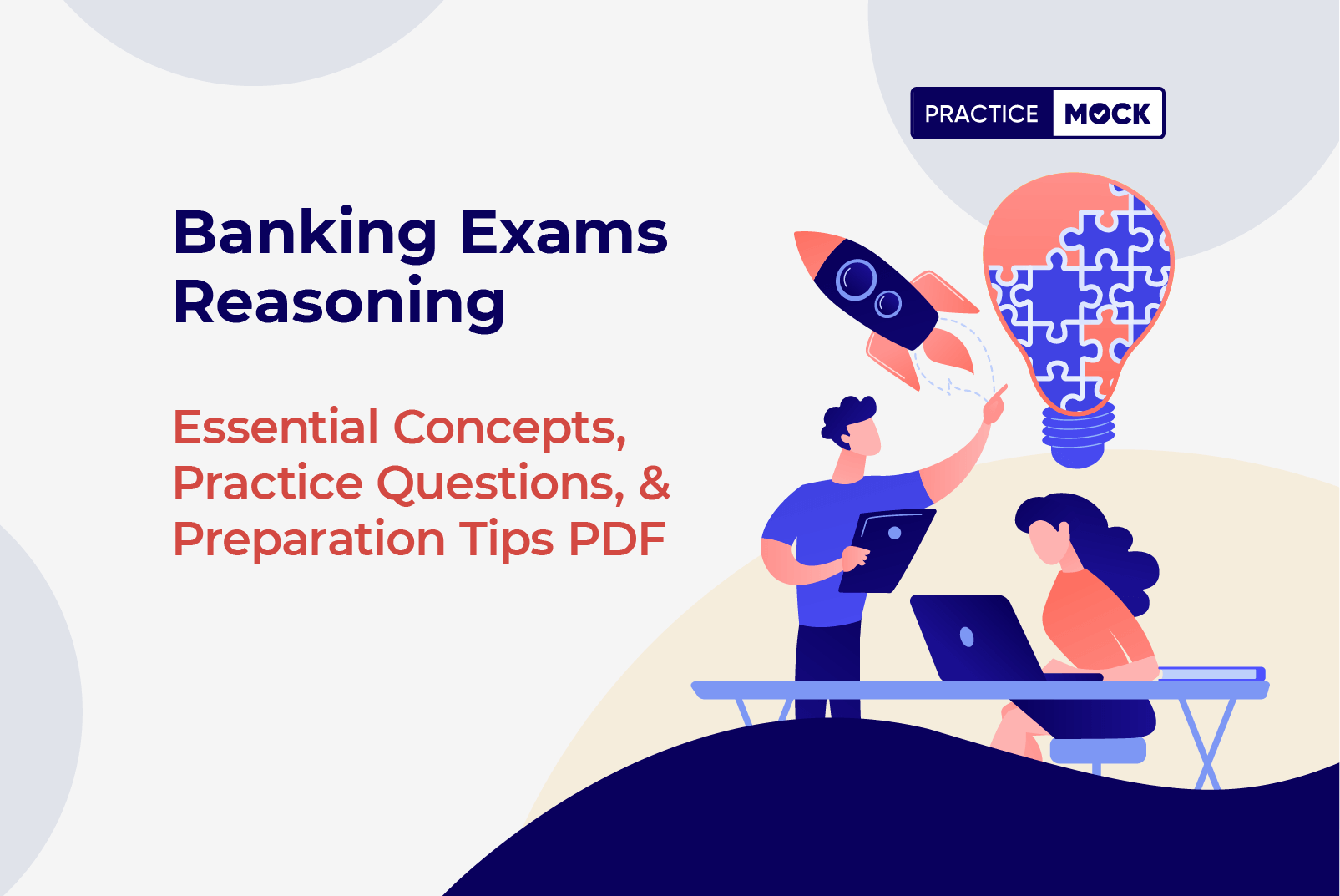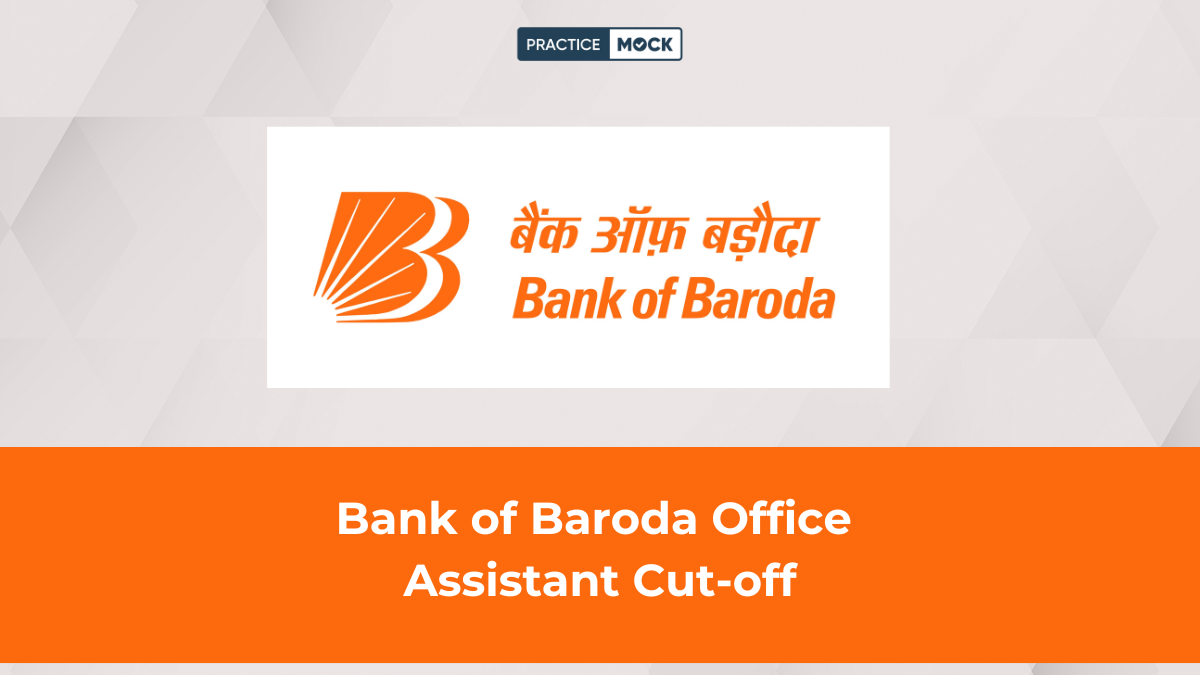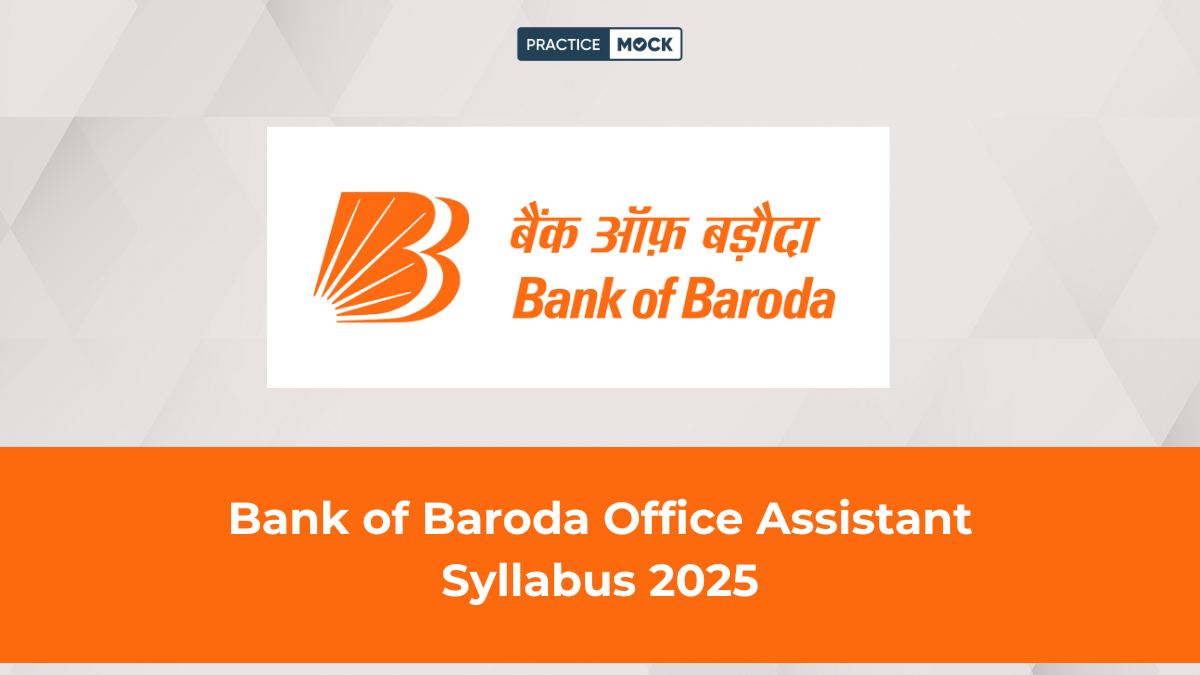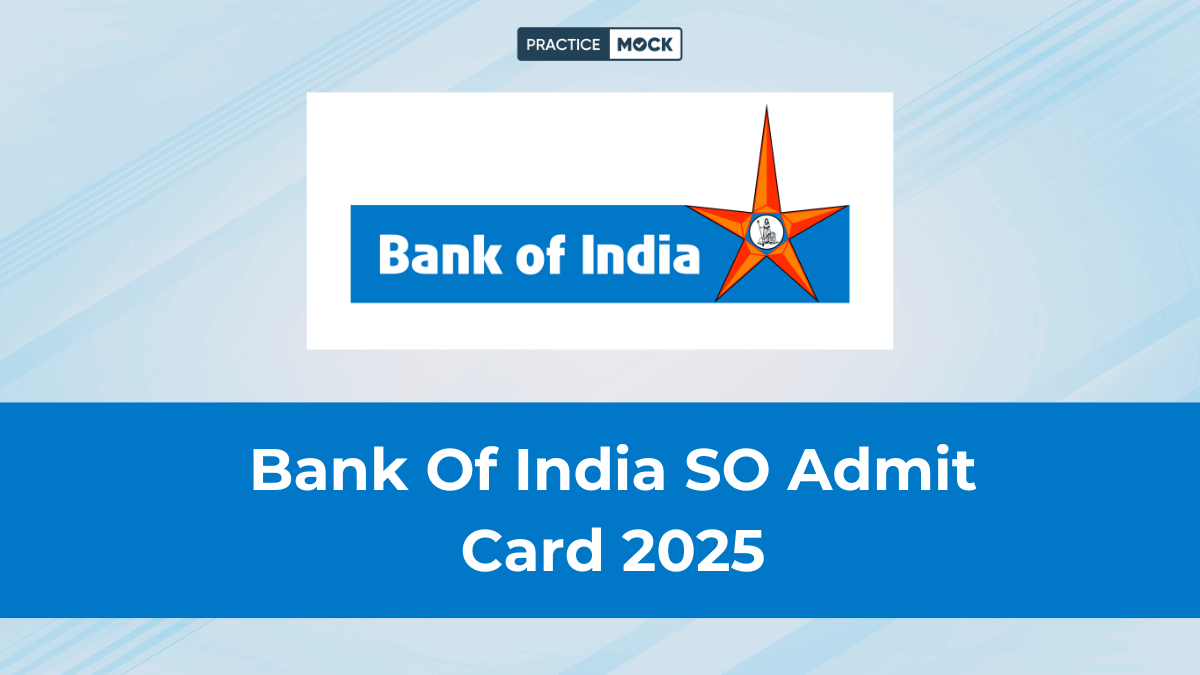Banking Exams Reasoning: Essential Concepts, Practice Questions & Preparation Tips Free PDF


All candidates applying for IBPS PO, SBI Clerk, SBI PO, RBI Assistant and other similar banking exams must study Reasoning Ability as this is one of the most prominent and important sections that facilitates analyzing a candidate’s analytical and thinking as well as decision making abilities. Solving the reasoning ability section in the examination can be very time consuming as the questions asked are a bit lengthy. In this article we will be discussing and guiding the aspirants with Banking Exams Reasoning Essential Concepts, Practice Questions, & Preparation Tips PDF.
This would be a comprehensive PDF that will be free to download in which all the important concepts are explained well. Along with the topic & concept explanations there are practice questions given along with their answer keys and detailed solutions. So, let’s catch up with these important concepts, practice questions and preparation tips PDF.
Download PDF – Banking Exams Reasoning Concepts, Practice Questions & Preparation Tips
Important Reasoning Concepts & Their Explanations
It is important to understand these critical concepts or topics for reasoning preparation especially for banks. Thus, it’s important for the candidates to prepare the below mentioned topics thoroughly.
- Blood Relations
- Syllogism
- Inequalities
- Ranking
- Seating Arrangement
- Puzzles
- Direction Sense
- Coding Decoding
- Miscellaneous
Banking Exams Quant: Essential Concepts, Practice Questions & Preparation Tips Free PDF
Blood Relations
Any relation in the world that is either by birth or marriage is a blood relation. For example, a relation by birth is father, mother, uncle, and son. While relations by marriage are father-in-law, mother-in-law, brother-in-law, etc.
Types of Blood Relations
A few types of blood relation questions are
- Dialogue or Conversation Based: In these types of questions a statement is laid by a person describing a relation. The person may or may not be personally related to the one stating it.
- Coding-Decoding: It is one of the recent types of blood relation questions, usually asked in the mains exam. In these questions, relations are represented by symbols.
- Based on Puzzles: The blood relations are described in the form of a puzzle. Brief information about the relation between people is provided and questions are asked on the basis of that.
Note: Never assume the gender of any person on the basis of the name.
RBI Assistant Free Mock Test 2023
How to Prepare Blood Relations Concept along with Practice Questions- Important for RBI Assistant
Syllogism
Syllogism is a very important topic of Logical Reasoning. It consists of few statements, which are followed by conclusions, you need to determine that among the given conclusions, which are correct/incorrect or follows/doesn’t follow. Syllogism basically checks the ability of a student to derive a conclusion or inference from the given statements. The statements and conclusions in syllogism may or may not be logical but while solving syllogism-based questions, you have to assume it to be 100% true.
Syllogism Types:
In Competitive Examination, Syllogism is a very important topic as this topic can help you to fetch 2 – 3 marks in both preliminary as well as mains examination. To cover this topic, first go through the basic concepts of syllogism and then solve the advance questions of syllogism. To master the topic, you should practice more and more questions related to different types of syllogism.
Types of Syllogism:
1. Basic Syllogism: In this type of syllogism questions, the statements are 100% true and the conclusion must be 100% true.
Example:
Statement: All Ball is Oval. Some Oval is Circle.
Conclusion: Some Ball is Circle.
The above conclusion is definitely false as we cannot derive any relationship between Ball and Circle from the above statement.
2. Complimentary pairs (Either – Or Case): In this type of syllogism questions, the statements are 100% true and two conclusions together can be partially true. Here are three cases when ‘Either-Or’ follows:
a. Some + Some not
b. Some + No
c. All + Some not
Example:
Statement: All Ball is Oval. Some Oval is Circle.
Conclusion:
1. Some Ball is Circle – False (As, there is no relation between Ball and Circle)
2. No Ball is Circle – False (As, there is no relation between Ball and Circle)
But if we consider both the conclusions together then, either conclusion 1 or conclusion 2 is true as this is a complimentary pair. If we consider the first conclusion to be true, the second conclusion is definitely false and if we consider second conclusion to be true, then the first conclusion is definitely false. So, both the conclusions together can be partially true.
3. Only – Only a few: This type of syllogism is conditional based syllogism. This is one of the most important concepts to be covered in syllogism as the questions based on ‘only – only a few’ is really confusing. If a statement says ‘only a few A is B’, then only a certain part of A is B and the remaining part is not B and if a statement says ‘Only A is B’, then All B is A, such that B can be only part of A.
4. Possibility based Syllogism: In this type of syllogism, the conclusion is based on possibilities e.g., if ‘All A is B’ and ‘No A is C’, then ‘Some C being B is a possibility’ is definitely true. In such type of syllogism, ‘can be’ or ‘possibility’ keywords are used.
5. Coded Syllogism: This type of syllogism usually comes in Mains examination, in which a comparison between two elements is usually defined by code i.e., symbol, number etc. For example: In, A&B, ‘&’ represents ‘some’, so we can interpret ‘Some A is B’.
6. Reverse Syllogism: This type of syllogism also comes in Mains examination. In this, few conclusions will be given, and you have to find out which statements given in the options will let follow all these conclusions.
RBI Assistant Free Mock Test 2023
How to Master Syllogism Concept along with Practice Questions- Important for RBI Assistant
Inequalities
Reasoning Inequality for Banking/Government exam
All major Banking and Government exams conducted in our country have questions based on reasoning inequality. At least 3-4 questions of 1 mark each, are asked and it is an easy to score topic from the reasoning ability section.
Basic concepts of reasoning Inequality:
In reasoning inequality, a group of elements are given, with a certain coded relationship denoted by <, >, = ≤ or ≥. Such type of questions falls under the category of reasoning Inequality.
The symbol used and their meaning are explained below.
1. P > Q means P is greater than Q.
2. P < Q means P is less than Q.
3. P = Q means P is equal to Q.
4. P ≥ Q means P is greater than or equal to Q.
5. P ≤ Q means P is less than or equal to Q.
In order to solve questions, understanding the order or the rank of these symbols is very important.
1. If A > B ≥ C is given, then A > C is true and not A ≥ C as, here the greater than sign is of higher order.
2. If A ≥ B is given, then either A > B or A = B is true.
3. If A < B < C is given, then A < C is true.
4. If A < B > C is given, then the relation between A and C cannot be determined.
Types of Questions asked in Inequality
To solve the questions based on inequality, the relation between the given elements is to be determined.
The three patterns in which the Inequality questions in reasoning are asked is as follows:
1. Basic/Normal inequality: In these types of questions, the elements are given and the relationship between them is marked with the help of the signs (<, >, =, ≥ and ≤). These types of questions are frequently asked in the preliminary exam of all major government exams.
For example: P < Q ≤ R ≥ S
2. Coded Inequality: This is a new format of inequality questions. Here instead of direct symbols, each sign is coded using a symbol, a number or an alphabet.
For example, ‘A#B where ‘#’ means A is greater than or equal to B’. Here, the ‘≥’ sign has been denoted with the ‘#’ sign.
This pattern is being followed in particularly the mains exam of all major government exams to make the questions complex and confusing. The coded inequality questions take a bit more time than the direct inequality questions, as the codes are first to be replaced with the respective symbols. Thus, the code based inequality questions require continuous practice to improve speed.
3. Missing symbol inequality: In these types of a question a statement is given with symbols missing. A relation, which needs to be satisfied, is given in the question and set of symbols which are to be placed in the blanks is given in option.
These questions can both be basic or coded.
For example:
Statements: A > B _ C _ D ≥ E
Which symbol are to be placed in the blanks so that A > C and C ≥ E?
(a) >, =
(b) <, =
(c) <, >
(d) <, =
(e) None of the above
Ans: a
Solution:
Here, when the symbols in option (a) are placed then, A > B > C = D ≥ E
Hence, option a.
SBI PO Prelims Free Mock Test 2023
Tips to Master Inequalities Concept with Practice Questions
Ranking
The ‘Ranking’ topic is one of the scoring topics in Logical Reasoning. It is based on arranging the position of people/objects in an order (ascending or descending) based on certain parameters such as height, weight, rank, etc. or you have to find out the position of people/objects from left to right/right to left or top to bottom.
Ranking and Order types:
In a competitive exam, different types of questions based on ranking and order are asked and the difficulty level varies from preliminary examination to mains examination. Mostly, in preliminary examination, the questions/arrangements are usually simple and direct, rather basic. While, in mains examination, the questions/arrangements are coded, indirect and puzzle based.
Few types of ranking and order are as follows:
1) Position Based – In this type of arrangement, you need to find the position of a person/object from left to right or vice versa.
1.a) Number of people/objects is known – In this type of arrangement, the number of persons will be known to you and you just need to find the position of a person/object from either left or right end.
1.b) Number of people/objects is unknown – In this type of arrangement, the number of persons will be unknown, so first you need to find the number of persons/objects and then you need to find the position of a person/object from either left or right end.
2) Rank Based – In this type of arrangement, you need to find the rank of a person/object from top to bottom or vice versa.
2.a) Number of people/objects is known – In this type of arrangement, the number of persons will be known to you and you just need to find the position of a person/object from either top or bottom.
2.b) Number of people/objects is unknown – In this type of arrangement, the number of persons will be unknown, so first you need to find the number of persons/objects and then you need to find the position of a person/object from either top or bottom.
3) Parameters Based – In this type of arrangement, you need to find the position of a person/object based on their height, weight, rank, etc.
4) Code Based Ranking – You will see Code Based Ranking questions mainly in mains examination; here, a comparison between two people or objects are usually defined by code i.e., symbol, number etc. For example: In, A&B, ‘&’ represents ‘taller than’, so, you can interpret ‘A is taller than B’.
SBI PO Prelims Free Mock Test 2023
Seating Arrangement
Seating arrangements are one of the most important topics for any competitive examinations. Seating arrangement questions are asked based on the arrangements of persons, objects etc. in or around different arrangements like Linear, Circular or Polygonal as per the situations and conditions given in the questions.
There are several types of Seating arrangement questions asked in reasoning section.
Types of Seating Arrangement:
Basically, there are four types of seating arrangement:
1.) Linear Seating Arrangement
2.) Circular Seating Arrangement
3.) Other Figure based Seating Arrangement
4.) Double Table based Seating Arrangement
All the above types of seating arrangement come in pre-exams in basic form but in mains these are clubbed with different topics of reasoning likes blood relation, direction etc. or more attributes are added to make it more complex.
1.) Linear Seating Arrangement:
In this type of seating arrangement questions, we have to arrange people, objects etc. in a row, double row or multiple rows as per the given conditions and situations.
This type of arrangements can be subcategorized into further categories,
a.) Single row same direction
b.) Single row different direction
c.) Uncertain row
d.) Double/Parallel row
e.) Multiple row
2.) Circular Seating Arrangement:
In this type of seating arrangement questions, we have to arrange people, objects etc. in a circle as per the given conditions and situations.
This type of arrangements can be subcategorized into further categories,
a.) Circular arrangement facing same direction
b.) Circular arrangement facing different direction
c.) Uncertain circular arrangement
3.) Other figures-based Seating Arrangement:
In this type of seating arrangement questions, we have to arrange people, objects etc. around different polygonal shaped tables, buildings, etc. such as Triangle, Square, Rectangle, Pentagon, Hexagon etc. as per the given conditions and situations.
This type of arrangements can be subcategorized into further categories,
a.) Arrangement facing same direction
b.) Arrangement facing different direction
4.) Double Table based Seating Arrangement:
In this type of seating arrangement questions, we have to arrange peoples, objects etc. around circular or polygonal shaped figures which is placed inside/outside of other circular or polygonal shaped table as per the given conditions and situations.
This type of arrangements can be subcategorized into further categories,
a.) Arrangement facing same direction
b.) Arrangement facing different direction
SBI PO Prelims Free Mock Test 2023
Puzzles
Puzzles are defined as a collection of clues or data which needs to be collectively analyzed and solved to form an arrangement, which depicts sensible information.
There are several types of Puzzle arrangement questions asked in reasoning section.
Types of Puzzle Arrangement:
1) Floor Puzzle
2) Scheduling Puzzle
3) Same Attribute Puzzle
4) Calculation Puzzle
5) Grid Matrix
6) Designation Puzzle
7) Box/Shelf Puzzle
All the above types of puzzles come in pre-exams in basic form but in mains exam these are clubbed with different topics of reasoning like blood relation, direction etc. or more attributes are added to make it more complex.
1) Floor Puzzle:
In this type of puzzle arrangement, candidates have to arrange people on different floors one above the other either in the same building or in different buildings as per the given conditions.
This can be subcategorized into further categories:
a) Basic
b) Vacant
2) Scheduling Puzzle:
In this type of puzzle arrangement, candidates have to arrange the persons, events etc. according to different Months, Years, Dates as per the given conditions.
3) Same Attribute Puzzle:
In this type of puzzle arrangement, candidates have to arrange persons, events etc. in two, three and four etc. different categories as per the given conditions.
4) Calculations Puzzle:
In this type of puzzle arrangement, candidates have to arrange persons, objects etc. as per the given conditions which is based on the calculations.
5) Grid Matrix
In this type of puzzle arrangement, candidates have to arrange persons or items etc. with different persons or items and form a matrix as per the given conditions.
6) Designation Puzzle:
In this type of puzzle arrangement, candidates have to arrange persons in different designations as per the given conditions.
7) Box/Shelf Puzzle:
In this type of puzzle arrangement, candidates have to arrange boxes/shelves one above the other as per the given conditions.
This can be subcategorized into further categories:
a.) Basic
b.) Vacant
SBI PO Prelims Free Mock Test 2023
Direction Sense
Direction is a theoretical line (physically or mentally) followed from a point of origin or towards a destination.
Cardinal points:
The four cardinal directions, or cardinal points, are the four main compass directions.
1) North
2) East
3) West
4) South
Relative to north, the directions east, south, and west are at 90-degree intervals in the clockwise direction.
Apart from cardinal directions, there are four intermediate cardinal directions.
1) Northeast
2) Northwest
3) Southeast
4) Southwest
The east and west are at right angles to north and south. The east is in the clockwise direction of rotation from north and west is directly opposite to the east.
Given below is a figure, which represents the cardinal directions and intermediate cardinal directions.
Coding Decoding
In coding-decoding, word or sentence is written in some specific manner by using some conditions. There are two types of coding-decoding.
1. Normal coding-decoding: Here, the sentences are written in specific manner such that two or three sentences have common terms or words to identify the codes. These type of questions are usually asked in prelims exam.
For example:
“Health was Wealth” is coded as “ax, bx, cx”, and “Garden was beautiful” is coded as “dx, cx, ex”.
Here ‘was’ is the common word in both the statements, so, there must be one common code which is ‘cx’. So, ‘was’ is coded as ‘cx’.
2. New pattern coding-decoding: In these ‘words’ are coded in specific manner based on different conditions. These type of questions are usually asked in Mains exam.
For example:
“ROCK WAS HARD” is written as “R@18, W#23, H@8”.
Here, we observe that if the word contains 4 letters then ‘@’ is used in the code, and if the word contains 3 letters then ‘#’ is used in the code. First alphabet of the word is the first alphabet of the code. Number in the code is the positional value of the first letter of the word.
Miscellaneous
Any ‘Series’ is the order of sequence of elements like – letters (or words), digits (or numbers) or symbols, and also any two or three elements which are arranged in such a manner that position of each element is defined according to some specific rules.
There are different types of series as given below,
1. Alphanumeric:
There are different type alphanumeric series which include elements among alphabets, numbers or symbols.
Alphabet-Number Series → P 8 G 7 H K W 2 3 T Y U 6 1
Number-Symbol Series → 5 8 % 2 $ # 1 3 & 9 4 ! @ 1
Alphabet-Symbol Series → W & Q R $ T H % @ A M &
Number-Alphabet-Symbol Series → 2 E & % W Q 1 3 P # L @
Example:
P 6 @ # D O 4 5 P % * ! S 2 & 3 F Z +
The common terminology used in the ‘series’ questions are given below:
Here, ‘@’ is preceded by ‘#’ and succeeded (followed) by ‘6’.
The 5th element from the left end is ‘D’, and 5th element from the right end is ‘&’.
The 3rd number from the left end is ‘5’, and 2nd number from the right end is ‘2’.
The 2nd alphabet (letter) from the left end is ‘D’, and 3rd alphabet (letter) from the right end is ‘S’.
The 3rd symbol from the left end is ‘%’, and 4th symbol from the right end is ‘*’.
2. Word Arrangement:
Series of words (or set of letters) are arranged in certain manner such that position of each letter is specified.
For example:
GNSI PELB STEB IOLP
Here, 3rd letter (from the right) of the 3rd word (from the left) is ‘T’ as 3rd word from the left is STEB, and 3rd letter from the right of STEB is ‘T’.
The 4th letter (from the left) of the 4th word (from the right) is ‘I’, as 4th word from the right is GNSI, and 4th letter from the left of GNSI is ‘I’.
3. Number Arrangement:
Series of numbers are arranged in certain manner such that position of each number is specified.
For example:
6315 8847 5231 9492
Here, 3rd digit (from the right) of the 3rd number (from the left) is ‘2’, as 3rd number from the left is 5231, and 3rd digit from the right of 5231 is ‘2’.
The 4th digit (from the left) of the 4th number (from the right) is ‘5’, as 4th number from the left is 6315, and 4th digit from the left of 6315 is ‘5’.
4. Alphabets:
Any word (or set of letters) where the letters are arranged in specific order.
For example:
‘PRACTICE’
Here, 2nd alphabet (letter) from the right is ‘C’, and 3rd alphabet (letter) from the left is ‘A’.
Here, as many letter are between P and T in the word is same the number of letters between them according to English alphabetical series. As, there are three letters between P and T in the word (R, A and C), and also there are three letters between P and T in English Alphabetical Series (Q, R and S).
5. Numbers:
Any number (or set of digits) where the digits are arranged in specific order.
For example:
‘64391829’
Here, 2nd digit from the right is ‘2’, and 3rd digit from the left is ‘3’.
Here, as many digits are between 6 and 9 in the number is same the number of digits between them according to whole number series (from 0 to 9). As, there are two numbers between 6 and 9 in the number (4 and 3), and also there are two numbers between 6 and 9 i.e., 7 and 8 in whole number series (from 0 to 9).
Download PDF – Banking Exams Reasoning Concepts, Practice Questions & Preparation Tips
These are some of the most important Banking Exams Reasoning Essential Concepts. For practice questions and prepration tips, download the free PDF link given above in the article.
RBI Assistant Free PDFs, Test Series, Study Material, Quizzes & Previous Year Paper
Recent Posts
IDBI JAM Notification 2025 Out for 676 Posts, Check Recruitment Age Limit, Cut off
IDBI Bank Junior Assistant Manager recruitment notification 2025 specifies the category-wise distribution of vacancies and…
IBPS RRB Clerk Previous Year Question Papers with Answers, Download Prelims and Mains Papers PDF
In this article, we are providing the IBPS RRB Clerk Previous Year Paper PDFs. Candidates…
IBPS PO Eligibility Criteria 2025, Check Age Limit and Educational Qualification
IBPS PO Eligibility Criteria highlights eligibility for the post of probationary officer at a public…
Success Story of Hema S, Cleared IBPS Clerk Canara Bank
In an interview with PracticeMock, Hema S. shared her journey of clearing the IBPS Clerk…
Success Story of Yogesh Bhargav, Cleared IBPS PO & Clerk
In an interview with PracticeMock, Shreyash Sharma shared his journey of clearing the IBPS PO…
Current Affairs for SSC CGL 2025, Practice Free Weekly Quizzes
In this blog, we have provided the latest Current Affairs for SSC CGL exam. Solve…



